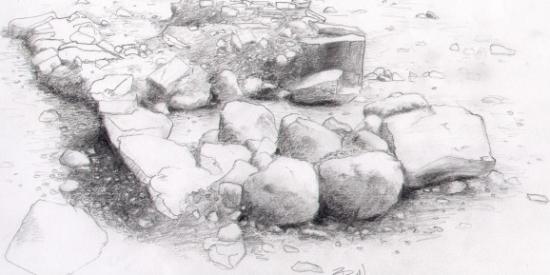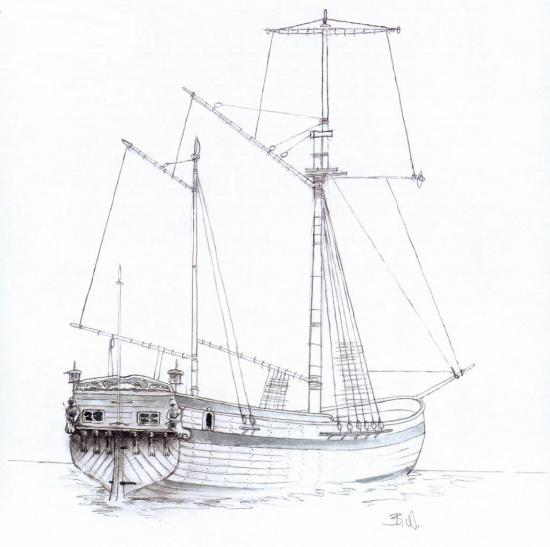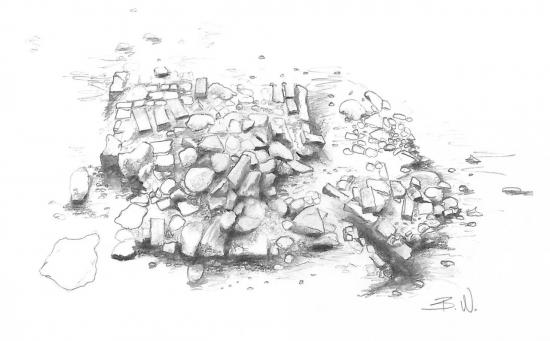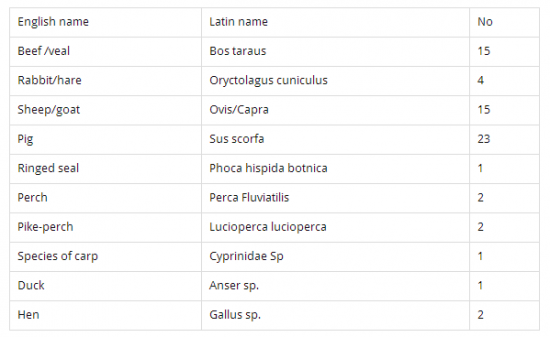Ulrica Söderlind
Source - http://www.heritagedaily.com/2013/02/examples-of-18th-century-cuisine-in-sweden-thanks-to-the-inn-at-koffsan/

Drawing of the foundation showing the bricks of the oven construction and the drainage from the stove. Drawing by maritime archaeologist Wallbom, Björn, Sweden.
How long inns along the coastlines of Scandinavia and around the Baltic have existed is very difficult to say; however, the first written records we have about them in Sweden come from Olaus Magnus, in his accounts about the Nordic people in the 1550s.
Olaus’ own references regarding this kind of establishment date back to 13th-century Germany. According to him, the first of these kinds of inns were built on the ice, and were in use until the ice broke in the spring. After some time, inns were built on the shore instead of on the ice, and could be used all year round. Very little research has been done in Sweden and Finland on this kind of establishment, even though some essays in the field have been written in archaeology at Stockholm and Södertörns universities, Sweden. The essays have a different kind of focus, such as the inns’ geographical locations, what kind of food and beverages were served, and the research potential for the inns. This article will try to highlight the legacy and heritage that can be found at such inns when it come to the 18th century cuisine in Sweden, the inn at Koffsan stands as the example.
KOFFSAN
Koffsan is a small island in Lake Mälaren, in the parish of Järfälla, in Sweden. During the 17th and 18th centuries, a tavern or inn was located on the island. The Swedish botanist Carl Linneus ( later known as Carl von Linné) visited the island on midsummer’s night in 1731. With him were 20 students from Uppsala, they went on a sailing ship transporting mail between the cities of Uppsala and Stockholm, however when they reached Stäket the wind slacken and the captain order everyone to go onshore when the finally reached the inn. While the students congregated at the tavern and started to drink beer and fall asleep, Linné himself explored the surroundings, and wrote his first flora on the island. All that remains of the building today is part of the foundations.
THE SITE AND ITS LOCATION
The site was excavated in 1993, and the reason for the excavation was that a major water company in Sweden was going to build a new bridge that was going to cross the remains of the tavern and destroy it. The excavation was therefore a rescue operation. The results of the excavation are a very good source for finding out what was served, regarding food and drink, to the guests during the 18th century, even if no excavation was carried out underwater. If one combine the archaeological material with written sources from the period, one can also find out how the food and drink was prepared, and sometimes even what it tasted like. Thanks to the excavation, the site is the only tavern that has been excavated in Sweden to date. The location of the tavern was very close to the water, which was common during the 18th century. Foundations of comparable buildings may be seen along the coast and lake shores all over Sweden. The only part of the tavern foundations that were visible before the excavation was part of a wall with measurements of ten by ten metres, and a height of approximately 0.4 metres. Slowly, the construction of the foundations emerged. The measurements were between nine by 5.5 metres, and the stove was 2.4 by 2.55 metres. The stove also included an oven. The foundations were made out of stone, bricks and a kind of mortar. After the foundations were completely exposed, they measured 15 by five metres. During early modern times, visitors to the establishment came by boat, either in small private ones or on larger boats that ran between Stockholm and Uppsala. The boats left Stockholm and Uppsala at similar times, but only made the trip on Mondays, Wednesdays and

Drawing of a replica of the same kind of sailing ship Carl Linneus and his student travelled with from Uppsala-Stockholm when they got stranded at Koffsan. Drawing by maritime archaeologist Wallbom, Björn..
Fridays. During the period April to August, the departure time was 4 am; during the period September to October it departed at 6 am; and during November, at 7 am. During the remaining winter months, there was no traffic on the route. Unfortunately, there is no information on how long the trip between Stockholm and Uppsala took with these ships. During the 18th century, Järfälla parish was a wealthy community with a large harvest of different kinds of crops, and the most important manor in the parish was located not far from the establishment. When one study old maps from the 18th century, one find that the manor had its own gardens, with various fruits, herbs, hops and a brewery. The accounts from the manor indicate that products from the different gardens were sold in Stockholm. It is very likely that the owner of the establishment on Koffsan also bought products from the manor to use for cooking, or seasoning schnapps, and so forth. Very close to Koffsan, several mills can be found on old maps, so it is also likely that the owner could buy newly ground flour in the neighbourhood.
THE FINDINGS
Here I will concentrate on the archaeological material that can be linked to food and beverages from the site. During the excavation of the site, many pieces of glass, ceramics, porcelain, coins and animal bones were found. Most of the bone material was discovered in the stove.

Drawing of the foundation with the stove clearly visible. Drawing by maritime archaeologist Wallbom, Björn, Sweden
There were no whole bottles found, but there was quite a large amount of pieces of bottles, comprising mainly necks and bottles. These pieces are different in size, colour and quality. Many of the pieces of glass came from the windows of the tavern, and show that the glass in the windows was green and yellow. The pottery from the site is domestic ceramic production, and is of high quality, with a range of colours, reflecting a great deal of imagination on the part of the potters. There was an increase in the production of ceramics and tiles in Sweden during the 18th century, when the most popular items were plates in different styles and shapes. Potsherds from coffee cups made of tin-glazed earthenware from the Swedish Rörstrand company were also among the findings. Other shards of porcelain came from the Swedish Marieberg and Gustavberg companies. Swedish porcelain and tin-glazed earthenware companies faced tough competition from porcelain imported from China. The imported porcelain was of a much higher quality than the domestic kind. Shards of Chinese porcelain were also found at the site during the excavation.

Table 1 Animalbones found in the stove during the excavation of the inn on Koffsan. The osteologgical analyze of the bones was made in 1999 by osteologist Jonsson, Gustav, Sweden.
A variety of animal bones was found at the site, although pig was most common. This was followed by beef, veal, sheep/goat, rabbit/hare, hen, perch, pikeperch, different species of carp, ringed seal and duck. The parts from the pigs, cattle, sheep/goats are the cuts that would have had the most meat on them. One reason why there appear to have been so few species of fish from the location may be that the types with more fat in them decomposed over the years. It is very common on archaeological sites that fattier species vanish from the archaeological record, especially fish containing small bones. The occurrence of ringed seal is rather surprising, because it is a species of seal without outer ears which lives in arctic and sub-arctic waters, the Baltic Sea, Lake Ladoga and Lake Saima. The ringed seal has never lived in Lake Mälaren, since it needs saltier waters. During the summer and autumn, the ringed seal is hunted using rifles, while in the winter clubs are used. The fishes was used for broth, soups, stews and sausages but also for dishes such as fried, boiled and baked, minced fish was for example seasoned with pepper, salt, nutmeg and egg, shaped into quenelles and then boiled. Thick butter sauce, caper sauce, different kind of brown sauces and sprat sauces was served to the different kind of fish dishes. I have not found any recipe for the ringed seal but there is no doubt that it was served at the site. The meat beef and veal was often salted, but not only, a warm beef salad could be done with thin slices of meat along with carrots, beet root and onion. Patés for example was made from the meat of beef and was also used to make quenelles, different kind of beef stews with different kind of root vegetables. The tongue itself was boiled, sliced and eaten with apples. The meat was also used for ragout, brawns and sausages; sweetbread was baked and held in high regard. Sheep’s, goats and lambs was also often salted but equal to the meat of beef not only, the tongues for example was boiled and sliced before eaten and the lungs were used to make a dish called “smashed lungs”. Roasts from the animals was prepared so it tasted like deer, the meat was then seasoned with vinegar and juniper bay leaf. It was also used to make fricassee, broth and different kind of ragout. The meat from both beef and sheep’s and lambs was prepared over the open fire on spits. Mustard, caper, cherry and olive sauce was served with pleasure to the meat dishes. Equal to the other meat the meat from pigs was also salted but also dried, boiled, fried and smoked. Pork brawn was made from the animals head. If one had an old animal and the meat was not good for anything else collared brawn was made. Small pigs and sucking pigs were usually fried over an open fire filled with a stuffing made of sage, soft bread and prunes. Pork was also used to prepare sausages, one sued equal amount of pork and beef meat and the mixture was seasoned with salt, pepper, ginger, clove and a really good beer.
CARL VON LINNÉS FLORA
From Carl von Linné’s first flora Flora Koffesiensis (1732) and notes from the location gives a good insight in the botanical material at the site. Linné listed 88 different species on the island. Amongthese 88 species, there are 18 that are suitable for use in preparing food and drink. Out of the 18 species, nine are also medicinal herbs, which were also suitable for the proprietor (she was a woman, but her name is unknown) of the establishment to use in preparing hernown schnapps. This schnapps could also be seasoned with berries, like hawthorn and wild strawberries. She could make pies out of strawberries or seasoned water,and then the water could be used to flavour other food dishes. She could make jam out of the strawberries, along with berries like redcurrants and gooseberries, and these berries would also have been very good for making wine or juice. Another possibility for these kinds of berries is that the owner stirred some sugar into them and served them as a dessert or as condiments with a main course, mainly meat dishes. Dandelion could be prepared and served as a vegetable, or it could be made into wine. If the roots were dried and ground, it made good flour to use in cooking meals. Dandelion is rich in vitamin C and several minerals. Another plant rich in vitamin A and C, potassium, calcium and iron is the stinging nettle. Leaves from the young stinging nettle could be used as a vegetable, served as a soup, or made into tea. Bird cherry could be used to make juice, liquor and seasoned schnapps. Vegetables was also served in its own rights, this was before the time of the potato in the country so different kind of root vegetables and pot-herbs played an important part of the cuisine, one example is a vegetable soup made from carrots, parsley, root vegetables, leeks, fresh spinach, broth from vegetables, green peas, butter, soft bread, cream eggs and egg yolk. I would like to mention some of the deserts and cakes that were in use and easily could have been made at the inn on Koffsan such as apple tart, pears in syrup and carrot cake. As and endnote I would like to say that I hope that the article shows what results one can reach from even a small but important source material regarding a countries cuisine when it is combined with written sources.